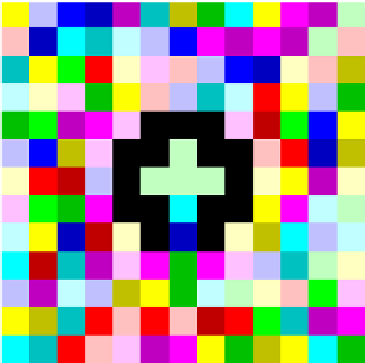Information Technology Reference
In-Depth Information
Fig. 9.1
Source code written
in the Piet language with two
dimensional, colour syntax.
Prints out the text “Hello,
world!”. Image © Thomas
Schoch 2006. Used under the
Creative Commons BY-SA
2.5 license
means of expression grew around computers as soon as access could be gained. In
Great Britain, interest during the 1960s grew into the formation of the Computer
Arts Society (CAS)
1
(Brown et al.
2009
). However after a creative boom CAS en-
tered a period of dormancy in the mid-1980s, perhaps drowned out by extensive
commercial growth in the computer industry at that time. CAS has, however, been
revived in more recent years, encouraged by a major resurgence of software as a
medium for the arts. This has seen a wealth of new programming environments
designed for artists and musicians, such as
Processing
(Reas and Fry
2007
),
Super-
Collider
(McCartney
2002
),
ChucK
(Wang and Cook
2004
),
VVVV
(
http://vvvv.org
)
and
OpenFrameworks
(
openframeworks.cc
)
, joining more established environments
such as the Patcher languages (Puckette
1988
),
PureData
and
Max
. These have
gained enthusiastic adoption outside a traditional base focused on academic institu-
tions, and have proved useful for teaching the conceptual visualisation required to
program computers.
Several artist-programmers have made their own, novel languages in which to
make their art. These often seem like esoteric languages that have found practi-
cal application. For example unique representations of time are central features of
ChucK and SuperCollider. Programming languages have themselves been exhibited
as works of art, such as the
Al-Jazari
music programming environment shown in
Fig.
9.2
(McLean et al.
2010
). Programming languages made for artists have cre-
ated new and emerging approaches to language design. This is not just a matter of
technical achievement, but brings important psychological issues to the fore.
What is the relationship between an artist, their creative process, their program,
and their artistic works? We will look for answers from perspectives of psychology,
cognitive linguistics, computer science and computational creativity, but first from
the perspective of an artist.


